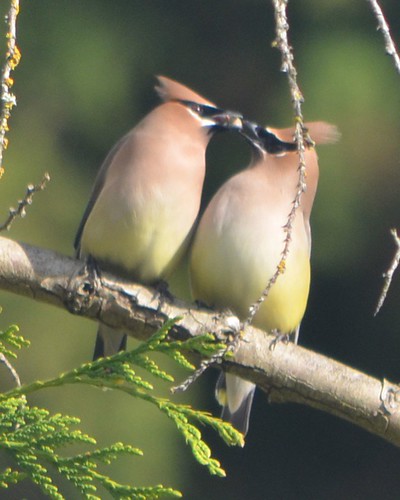If you think holiday overindulgence is an exclusively human activity, think again. The birds do it, too, and one of the most common offenders here on the Hill is a little fruit-loving passerine called the cedar waxwing.
Last Aviary, we saw birds that kill their own brain cells. This week we’re seeing birds that get drunk.
The cedar waxwing is a small gray bird with a black mask and a pointed crest. If you look closely, you may notice a few splotches of red on the wings and a bright yellow band on the tail.
Waxwings subsist mainly on fruit. Their bodies are well adapted to this diet—unless the fruit rots and ferments before they eat it. Then the birds get intoxicated, which makes them sick. When they fly drunk, they sometimes have fatal collisions with cars or the ground. (In the spirit of the holiday season, let’s give thanks that the humans on the Hill don’t have wings.)
In late fall, waxwings rely heavily on mountain-ash berries as a food source—but American robins do, too. You may not think of the robin as a particularly fierce bird, but a single robin can defend a fruiting mountain-ash tree from a flock of up to fifteen waxwings. Perhaps partly because of this, waxwings have adapted to travel in large flocks. When their numbers are high enough, they’re better able to take possession of and defend their food resources.
Waxwings are constantly on the move as they look for their next fruit fix, so if you want to find them, you need to look for the foods they prefer. If there are any mountain-ash berries left in your part of the neighborhood, they’re your best bet. Otherwise, look for waxwings on any tree or bush that still has fruit on the branches—especially junipers, dogwoods, apple trees, and fruiting ornamental plants.
Interested in learning more?
- Check out the cedar waxwing’s page at the Cornell Lab of Ornithology.
- Listen to the call of the cedar waxwing at the Macaulay Library of Natural Sounds.
- If you aren’t familiar with the plants mentioned above, check out the websites What Tree is It? and botany.com—or find a good field guide.
- Just in case animal intoxication amuses you, I give you drunken monkeys, elephants, and bears. Oh my!
More Capitol Hill Aviary
- Hill chickadees kill their own brain cells
- Flickers empty Hill birdfeeders
- Hill serves as winter destination for dark-eyed juncos
- More…
Melissa Koosmann is a freelance writer and resident of Capitol Hill. She writes about education, culture, and nature — and, sometimes, birds for CHS.




“Last Aviary, we saw birds that kill their own brain cells. This week we’re seeing birds that get drunk.”
Friday night, police discovered Speckle Breasted Tweakers running a meth lab under the eaves of the restrooms in Cal Anderson Park. Passersby, offended by deafening dance mixes comprised entirely of samples of song birds being crushed between cymbals, called the authorities after they observed the doomed avians’ incessant clattering and grinding of their sadly splintered rotting brown beaks, clouded red eyes, failed attempts to fly at 4:00 am, and sublime indifference to breadcrumbs and condoms.
My partner and I were out walking in the Hill the other day and I saw these, but the only birds I can identify are chickadees so I had no idea what they were.
Wow, thanks for the tip. I’m on the beat!
Stupid Speckle Breasted Tweakers. There were a couple of them crapping in the shrubs outside our building last night around three. Left a bunch of bird seed wrappers around. And last week I saw a few of them trying to untie and steal that bird feeder from the tree on Thomas just down the hill from 11th. I watched them for several minutes before they realized I was there, and then they flew off.
Cool. I’m glad you saw some of these birds. They’re fun ones to watch.
Melissa: Thanks for your great work to capture bird facts & lore here on the Hill. I really enjoy reading each installment!
Mark–Glad you enjoy them! They’re fun to write, too.